Keith Alexander, Jill Butler and Ted Green
Which trees are the most valuable to wildlife? Are tree and shrub species not native to Britain of any value for wildlife? These are two common and fundamental questions, but neither has been satisfactorily answered. The natural history and nature conservation literature is full of partial attempts, some well-informed, some less so.
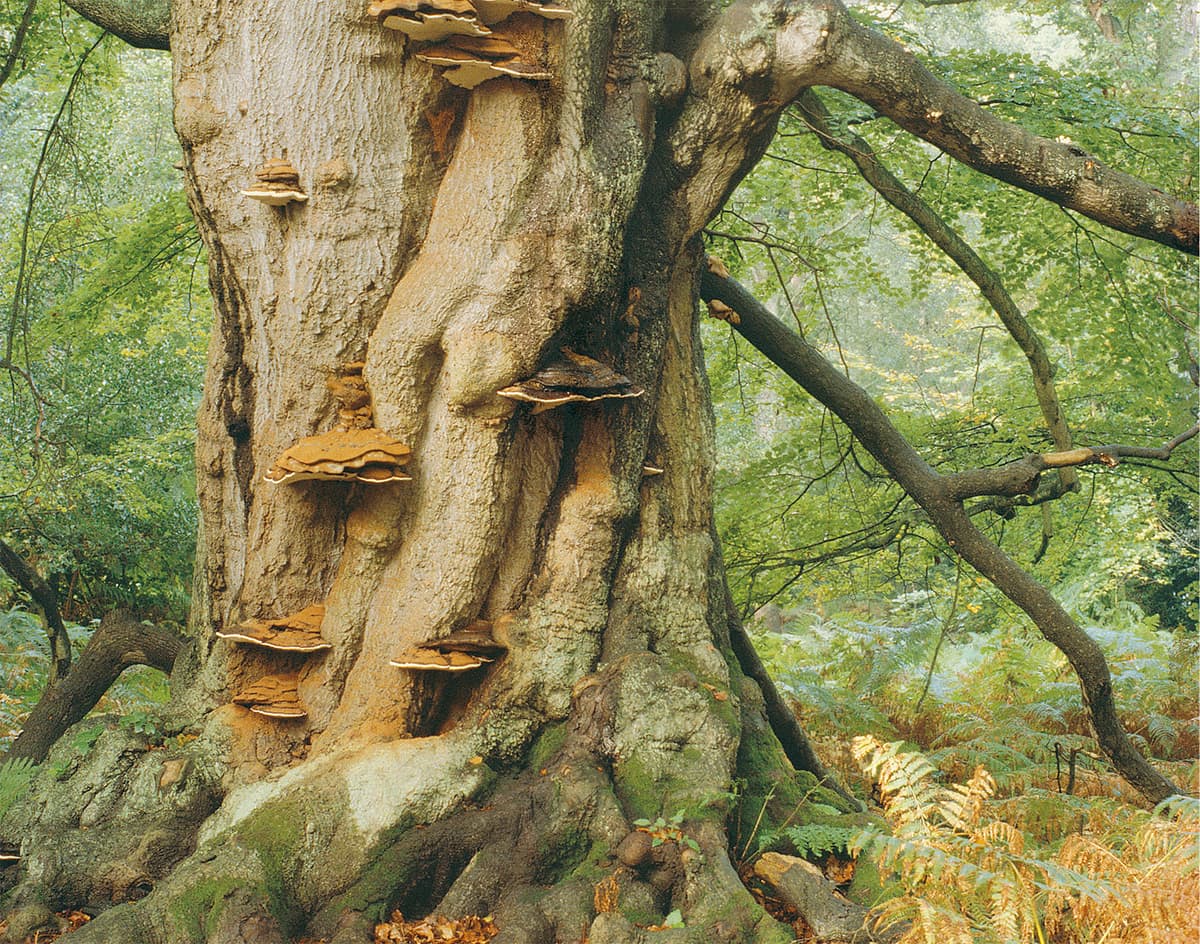
A veteran open-grown beech tree providing excellent quality habitat for wood-decay fungi and wood-decay invertebrates. The large bracket is the common southern bracket Ganoderma australe which forms extensive white-rot within the dead heartwood tissues within and this forms very high quality habitat for specialist invertebrates. Note also lateral branching supports a different range of invertebrate species. (Ted Green)
An article addressing these issues was first written by the authors for British Wildlife magazine (October 2006) because of our concerns about the lack of awareness of the true value to wildlife of our trees.
In view of the current explosion in tree planting schemes we thought it important to bring it to a wider audience. The first scientific comparison of the value of different tree and shrub species to wildlife was made by Professor Richard Southwood (Southwood, 1961). His hugely influential paper focussed only on the insect species that feed on foliage. This was updated some 20 years later (Kennedy & Southwood, 1984), incorporating data on mites as well as other material which had subsequently become available. There is of course considerably more to woody plants than their value to foliage-feeding insects and mites. We offer here a preliminary assessment of a wider range of values of trees and shrubs to wildlife in general.
A key reason for expanding Southwood’s work is the extent to which it is being misapplied by many of its readers. How often have we seen statements such as ‘oak is the most important tree to British wildlife’, based on Southwood’s insect species-richness data? The statement may well be true, but Southwood never claimed to show that!
We also regularly hear or read that oak ‘supports more than 400 species of invertebrate’, but, of course, no one tree – or even one site – supports each and every one of these invertebrate species. This is equally true for other groups of organisms. The presence or absence of species on a particular site is dependent on a whole host of factors, especially the mobility of the species concerned, their ability to find and colonise places that are suitable for them.
Representation of tree- and shrub-associated species will also vary across the year, according to the age of the individual plant and its condition. Kennedy & Southwood identified the most significant variables affecting species richness in foliage insects as: host tree abundance, time present in Britain, and whether or not the foliage is evergreen, with some significance due to taxonomic isolation, tree height and leaf size. Again, these are also significant beyond just foliage-feeding invertebrates.
Southwood’s compilation is of species closely associated with a single host tree or shrub species, and he purposely omitted organisms which feed on a wide range of hosts – these comprise a very significant proportion of the British invertebrate fauna.
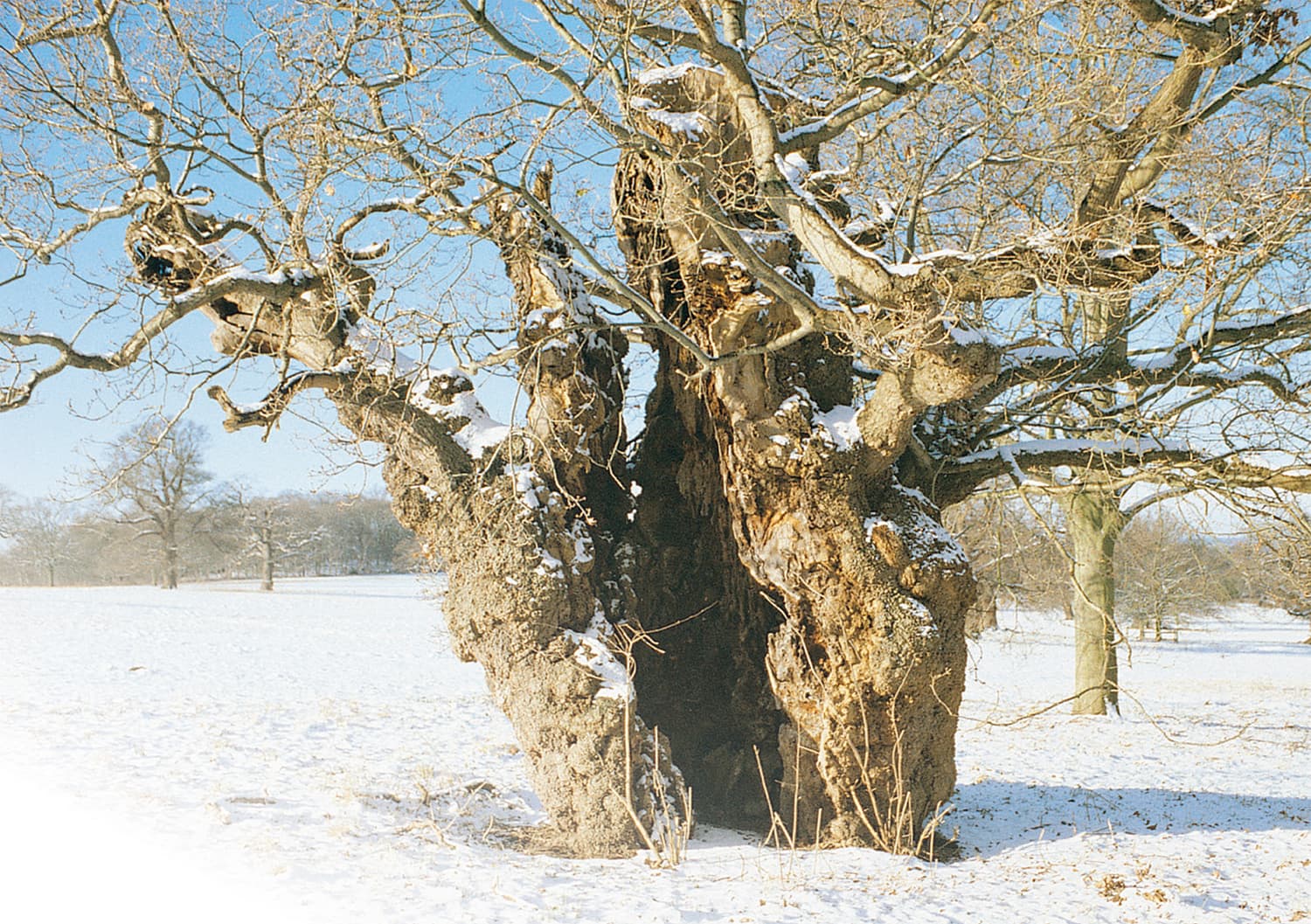
An ancient open-grown oak in wood pasture, the richest habitat for biodiversity in the UK, showing advanced hollowing and fragmentation of the trunk as the girth expands beyond the maximum feasible for a complete new growth ring. Hollowing supports a good range of rare and threatened invertebrates. (Ted Green)
Defining the wildlife of trees and shrubs
Living trees and shrubs actually support and are supported by a very wide range of other organisms, including:
- mycorrhizal communities in the soil (the fungi as well as organisms which feed on them);
- soil-inhabiting organisms (such as bacteria, yeasts, nematodes, mites) associated with tree roots both live and dead roots;
- decay communities within dead areas of wood (fungi, invertebrates, etc.);
- decay communities which exploit fallen dead leaves (fungi, invertebrates, etc.);
- epiphyte communities which exploit all surfaces, bark, wood and leaves (lichens, mosses, liverworts, algae, as well as species which shelter amongst them and feed on them);
- animals which feed on pollen, nectar, fruits, seeds, as well as the foliage-feeding communities; and
- animals which feed on the fungi (mycelium and fruit bodies) and animals that live on the plants.
This list is by no means complete. We intend to expand on various aspects of this subject in future magazines.
The value of trees will also depend on whether they are of open-grown form or close-grown within groups, the former being by far the most valuable – as individual trees – for wildlife in general (Green, 2010). The tree standing as an individual, usually in the shape of a hemisphere or cone, is able to realise its full potential leaf area and flowering (we are calling them ‘pollen’ trees). This therefore influences and maximises pollen and fruit production by comparison with a tree grown in competition with others, e.g. in high forest where the development of individual tree canopies is significantly limited – German research has indicated it is different by a factor of 20 times. The open-grown tree has been recognised as the most productive form for producing fruit and tree seed across the world for perhaps millennia – this was known by the swine herders and gives the ‘acre’ its name (aecer, akker, acker etc. was the term used in Old English for the place where pigs went out to fatten on the acorn mast and came to mean a unit of mast for one pig). Scattered trees have also been recognised as keystone structures for biodiversity and cultural landscapes and even in modern landscapes. Dense stands of trees, however, provide conditions of shade and humidity required by many other species which are outside the scope of this article.
The large horizontal lower structural limbs of open-grown trees increase in girth comparable to the increase in trunk circumference and likewise go on to hollow as well. Horizontal limbs catch the light differently to vertical structures and hold water for longer so they provide different niches for wildlife not found on plantation trees.
The palatability and medicinal value of tree foliage to large herbivores are areas of growing interest not covered here. With the current interest in ancient trees we are now more aware that their values to wildlife also change as trees develop and age – a successional development, with older examples generally providing the greatest wildlife value. Other variables include altitude, microclimate, the proximity of other tree species, region, and genetic variation within the species. The wildlife value of a tree species is not a fixed attribute.
Constructing a simple presentation of the information
We decided therefore to make a first attempt at presenting some of this huge array of information in a simple form which could then be used in a more sensible and constructive way by naturalists, conservationists, arborists, etc., without specialist expertise.
The resulting table was not easy to construct. The underlying data are dispersed widely in the scientific literature and would have been a monumental task to compile. A pragmatic decision had to be made: we would draw on our own experiences and recollections, with the help of many colleagues who have published elsewhere (see References), rather than on a detailed study of the literature! The table is therefore presented as a preliminary analysis in the hope that it will inspire others to tackle a full literature review in due course.
The next issue to address was criteria. The different trees and shrubs needed to be compared and contrasted on a level playing field, so far as this is possible. In the table we have tried to consider each woody species as growing under conditions where the fullest complement of associates might be expected. The trees and shrubs are assumed to be maidens – that is, without a management history as coppice or pollard. They are assumed to have had space to develop their full biological potential, i.e. not constrained by commercial considerations.
The issue of native versus non-native and provenance is essentially avoided in our table. The use of these terms is too restrictive, especially in the context of the necessary mobility of species as the climate changes. We have selected the most widespread species to be found today in the British countryside. The Joint Nature Conservation Committee considers all plants thought to have been introduced prior to 1500, such as sycamore, sweet chestnut, larch and Norway spruce, as naturalised archaeophytes, although this is hypothesis and not fact (Green, 2005). Gardens, arboreta and commercial plantations were not considered.
The term ‘native’ is widely used and abused, with little reference to its precise definition(s). The word actually refers to the place of birth but is commonly used in natural history to refer to the range of a particular species which was established before it is believed that people had a significant impact. This is rarely a useful starting point – reliable evidence is generally lacking, and the approach denies the natural dynamism of species’ ranges. Beech is a classic example. This species would almost certainly have continued colonising Britain from its early range in the south-east, but people have distorted the natural expansion through widespread plantings. It is believed, for example, that beech is not native in northern Britain and yet, had it not been planted, it may well have reached there by now under its own steam.
Introductions are not necessarily poorer for wildlife as many species are not precisely tied to a particular tree or shrub species but can exploit others to some extent, especially where the introduced plant is taxonomically close to a native species, or where structural similarities are present. Often they provide the necessary conditions when the usual host is not present. Many examples come to mind. Quite a few invertebrate species associated primarily with field maple are capable of living on sycamore and vice versa. The bark conditions found on sycamore have proved very beneficial to many epiphyte species, including some nationally rare and threatened species.
Wood-decay communities exhibit many fascinating patterns between tree species, a good example being provided by the heartwood of sweet chestnut and false acacia Robinia which decays in a very similar way to oak and supports some of the invertebrate species more associated with decaying oak – the heartwood-decay fungus Laetiporus sulphureus, not the host tree species, is the link. At many sites in the UK sweet chestnut is the key tree species associated with the mycorrhizal group known as the stipitate hydnoids (hedgehog fungi), which are now Species of Principal Importance for the conservation of biodiversity under the 2006 Natural Environment & Rural Communities (NERC) Act. Ectomycorrhizal associations which re usually associated with birch and beech have been found with Nothofagus species.
However – as Southwood has shown – a wider range of associates may be expected if the tree is growing within its native range. Equally, the representation of associates will vary across that range as each associate will have its own range and mobility. Representation of associated species may perhaps be greater in the centre of the range, lower at the edge, and very restricted when the tree has been planted beyond its native range. In this article we are basing our thinking at the biogeographical level of Britain alone, but there will be regional variations. A good example is ash and its wood decay communities. Ash tends not to be regarded as a rich tree species for deadwood invertebrates, which to some extent may reflect regional patterns in the availability of ancient ash trees. However, it is one of the most important trees in the Cotswolds, supporting a large array of British Red Data Book and Nationally Scarce insects, including the famous violet click beetle Limoniscus violaceus. Another example is given by two fungi – birch polypore Piptoporus betulinus which predominates in the south and hoof fungus Fomes fomentarius that has a more northerly distribution, but both decay the wood of birch.
The different wildlife assemblages have been ordered across the table in what seemed to be a logical sequence, starting with the group of organisms which really drive ecosystems – the fungi – followed by the invertebrates which exploit the trees and the fungi, and then moving to the complex associations with leaf litter, blossom and fruits. Epiphytes come next. We considered including a final column dealing with the very complex associations with birds and bats, but we have decided to cover this topic with just a brief discussion.
We have chosen to present the degree of value of each feature on a scale of one to five. A single asterisk indicates estimated low value, while five asterisks indicate relatively high value to wildlife, with two, three and four indicating scales of intermediate values. It is important to stress that these are provisional rankings, or suggestions, and are not intended to be the last word on the subject.
The quality and quantity of species assemblages associated with the widespread trees and shrubs of the British countryside.
| Tree type |
Mycorrhizal fungi |
Wood decay fungi |
Wood decay invertebrates |
Foliage invertebrates |
Biomass of foliage invertebrates |
Epiphytic lichens, mosses, etc. |
Leaf litter |
Fruits and seeds |
Blossom for pollen and nectar |
| Pinaceae |
| Norway spruce |
***** |
** |
*** |
*** |
*** |
* |
* |
**** |
*w |
| European larch |
***** |
** |
* |
** |
*** |
* |
* |
**** |
*w |
| Scots pine |
***** |
*** |
**** |
**** |
**** |
* |
* |
**** |
*w |
| Taxaceae |
| Yew |
***G |
** |
* |
* |
** |
* |
* |
**** |
*w |
| Platanaceae |
| London plane |
***G |
** |
* |
* |
* |
* |
* |
* |
*w |
| Ulmaceae |
| Elms |
***G |
**** |
*** |
*** |
*** |
***** |
**** |
* |
*w |
| Juglandaceae |
| Walnut |
***G |
** |
* |
* |
* |
* |
*** |
* |
*i |
| Fagaceae |
| Beech |
***** |
***** |
***** |
*** |
* |
***** |
* |
***** |
*w |
| Sweet chestnut |
*** |
*** |
*** |
* |
* |
* |
* |
***** |
*i |
| Turkey oak |
* |
*** |
**** |
* |
* |
* |
*** |
* |
w |
| Evergreen oak |
*** |
*** |
* |
* |
* |
* |
* |
***** |
*w |
| Native oaks |
***** |
***** |
***** |
***** |
***** |
***** |
*** |
***** |
*w |
| Betulaceae |
| Birches |
***** |
**** |
**** |
***** |
**** |
**** |
*** |
**** |
*w |
| Alder |
*** |
*** |
** |
* |
**** |
** |
*** |
**** |
*w |
| Hazel |
** |
*** |
*** |
*** |
*** |
**** |
**** |
*** |
*w |
| Hornbeam |
*** |
** |
** |
** |
* |
** |
*** |
*** |
*w |
| Tiliaceae |
| Limes |
**** |
*** |
** |
** |
*** |
** |
**** |
* |
****i |
| Salicaceae |
| Poplars |
*** |
*** |
*** |
**** |
*** |
* |
*** |
* |
*w |
| Goat and grey willows |
*** |
*** |
*** |
***** |
*** |
**** |
*** |
* |
*****i |
| Crack, white and other rough-barked willows |
**** |
*** |
*** |
**** |
*** |
* |
*** |
* |
*****i |
| Rosaceae |
| Cherries |
***G |
** |
* |
*** |
** |
* |
**** |
***** |
****i |
| Plum |
***G |
** |
*** |
*** |
*** |
* |
**** |
**** |
****i |
| Pear |
***G |
** |
*** |
**** |
*** |
*** |
**** |
*** |
****i |
| Apple |
***G |
** |
*** |
**** |
*** |
*** |
**** |
**** |
****i |
| Rowan and whitebeams |
***G |
** |
* |
* |
* |
*** |
**** |
**** |
****i |
| Hawthorns |
***G |
** |
*** |
**** |
*** |
* |
***** |
**** |
*****i |
| Fabaceae |
| False-acacia |
***G |
** |
*** |
* |
* |
* |
*** |
* |
****i |
| Aquifoliaceae |
|
|
|
|
|
|
|
|
|
| Holly |
***G |
* |
* |
* |
** |
** |
* |
**** |
*****i |
| Hippocastanaceae |
| Horse chestnut |
***G |
** |
*** |
* |
* |
* |
** |
* |
****i |
| Aceraceae |
| Field maple |
***G |
** |
** |
** |
* |
*** |
*** |
* |
****i |
| Sycamore |
***G |
*** |
*** |
** |
***** |
***** |
***** |
* |
****i |
| Oleaceae |
| Ash |
***G |
*** |
***** |
*** |
* |
***** |
***** |
* |
*w |
Notes
- We have chosen to present the degree of value of each feature on a scale of one to five. A single asterisk indicates estimated low value, while five asterisks indicate relatively high value to wildlife, with two, three and four indicating scales of intermediate values. It is important to stress that these are provisional rankings, or suggestions, and are not intended to be the last word on the subject.
- Trees and shrubs are listed in taxonomic order (Preston et al., 2002) to facilitate comparison of close species.
- Most tree species are ectomycorrhizal, the exceptions are indicated as G (= glomalean endomycorrhizal).
- The blossom column also indicates which tree species are wind (w) or insect (i) pollinated.
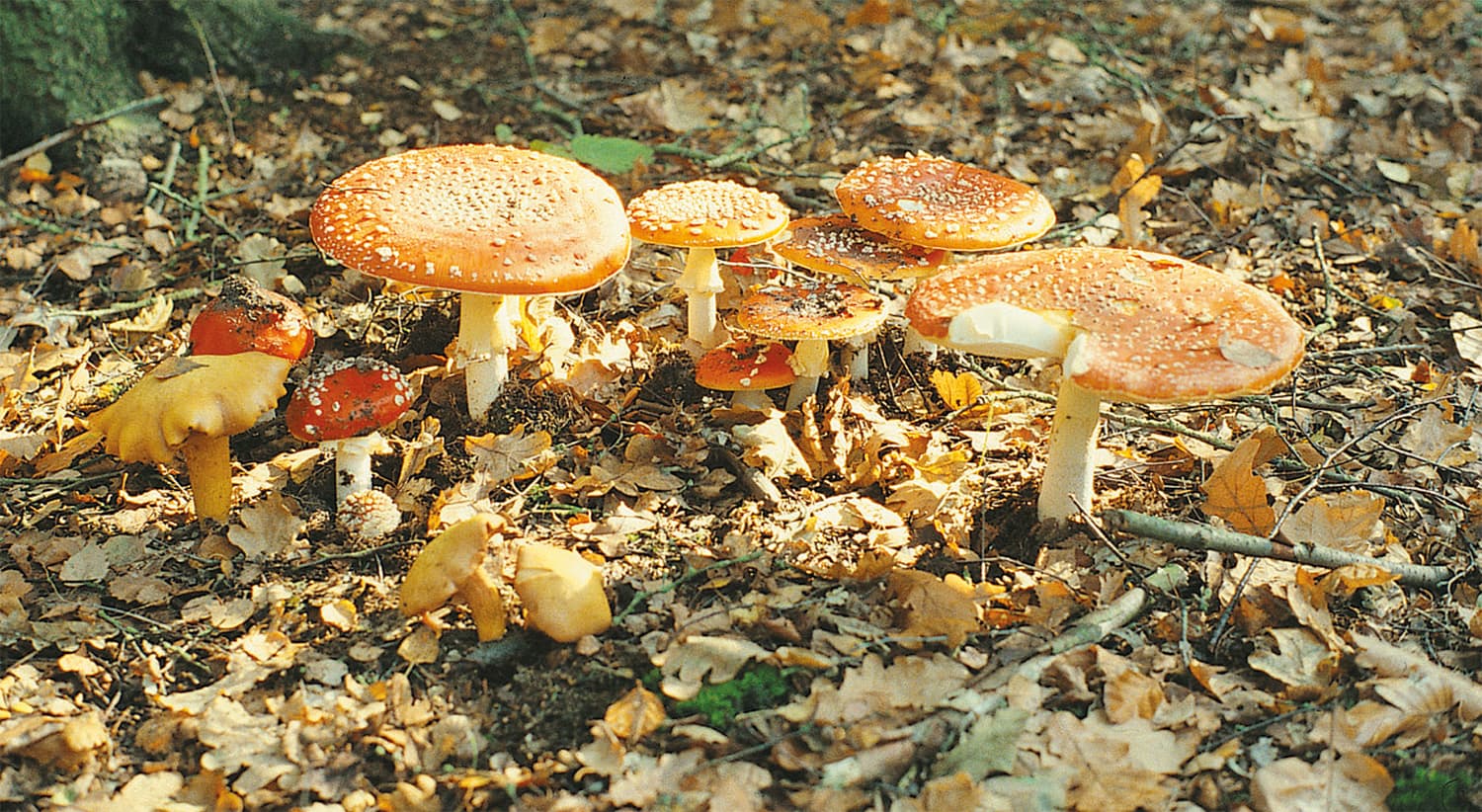
Mycorrhizal fungi. Amanita muscaria fly agaric and Pseudoboletus parasiticus. The Amanita group are essential partners with plants. This boletus also plays an essential role but can also be parasitic on other fungi. (Ted Green)
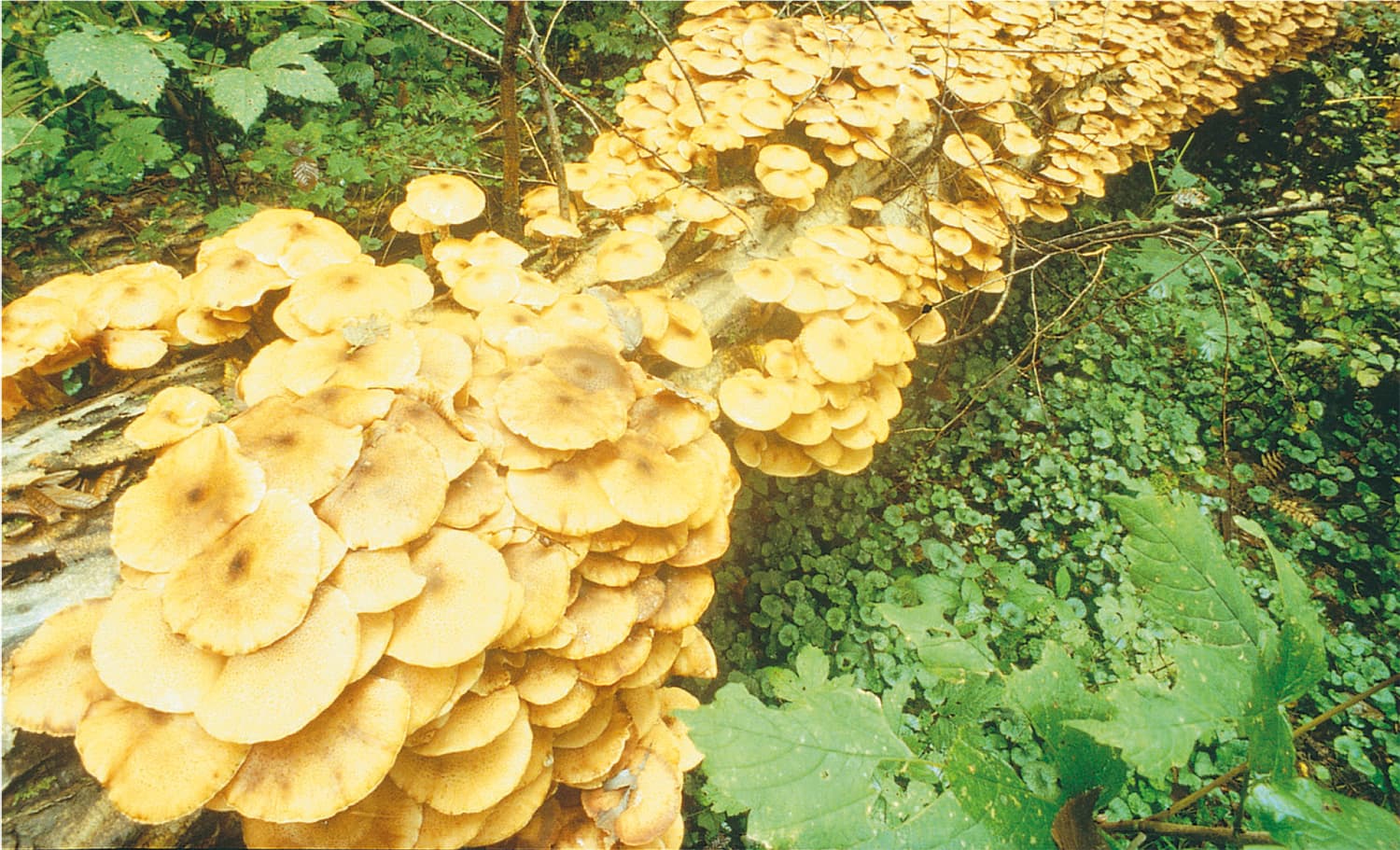
Armillaria gallica is the major fungus colonising and recycling this decaying tree trunk. (Ted Green)
Mycorrhizal fungi
‘A tree without mycorrhiza is a dead tree.’
James Merryweather (2001)
As mycorrhiza have been an integral, formative component of all biological communities since life on land began – and the partners are interdependent – it is difficult to consider the fungi alone and separate from the plants they support (J.W. Merryweather, personal communication). To give them a star rating lower than the full five when they are essential to the majority of plants could also misrepresent their importance. However, we are attempting to compare species-richness and uniqueness of the composition of the mycorrhiza in the table, and so it seems sensible to score down some tree and shrub species which are thought to have fewer species associations with mycorrhizal fungi and those which are associated with fungi which have a wide range of hosts. Merryweather (2001) and Spooner & Roberts (2005) provide modern reviews of the association between the different tree species and their mycorrhizal fungi, while Allen (1991) is a useful introduction to mycorrhizal ecology.
Merryweather (2001) also provides a useful description of the two different types of mycorrhiza. The ectomycorrhizal fungi ensheath roots but do not penetrate root tissue, and many produce recognisable mushrooms. The endomycorrhizal fungi actually penetrate root cells to exchange nutrients and are invisible without a microscope. Most trees and shrubs are actually ectomycorrhizal, and so the exceptions – the glomalean endomycorrhizals – are indicated by a ‘G’. This in itself is an oversimplification as some – birch and willows – seem to be endo- when young and ecto- when mature, though it is possible that they are both types sometimes, or in certain circumstances. The situation may change over time or perhaps be continually changing.
The majority of ectomycorrhizal fungi produce fruit bodies – mushrooms – many of which are favoured foods of many invertebrates and mammals.
Wood decay fungi
‘A sustainable, structural, successional supply of decaying wood from acorn to ancient.’
Ted Green
Trees and shrubs are woody plants, laying down additional wood each year as an annual ring. The inner, older rings gradually die and therefore this dysfunctional (dead) woody tissue accumulates with age. These tissues are eventually colonised by fungi and other microorganisms and decomposition progresses. Other dead woody tissues begin to develop and accumulate in parallel – in shaded-out twigs and branches, areas of damage, etc. Tree species differ in whether they have true heartwood, e.g. oak and sweet chestnut, or ripewood, e.g. beech, ash and birch, although it is thought that this distinction probably has little impact on the actual wildlife values of the tree species concerned. All tree species are assumed to hollow naturally at some time in their life through the activity of fungi and other micro-organisms. Thus the older stages for any particular tree or shrub species will support a wider range of wood-decay associates.
Spooner & Roberts (2005) include a tree-by-tree review of decay fungi, and more detail can be found in Raynor (in prep.), Rayner & Boddy (1988) and Schwarze et al. (2000).
Fungal fruit bodies – both the soft fleshy ones produced annually and the woody textured ones which can be present for many years – provide habitat and food for a wide range of animals. As they are more abundant in late summer and autumn, the invertebrate biomass is a resource for other animals at a time of the year when other food supplies are in decline.
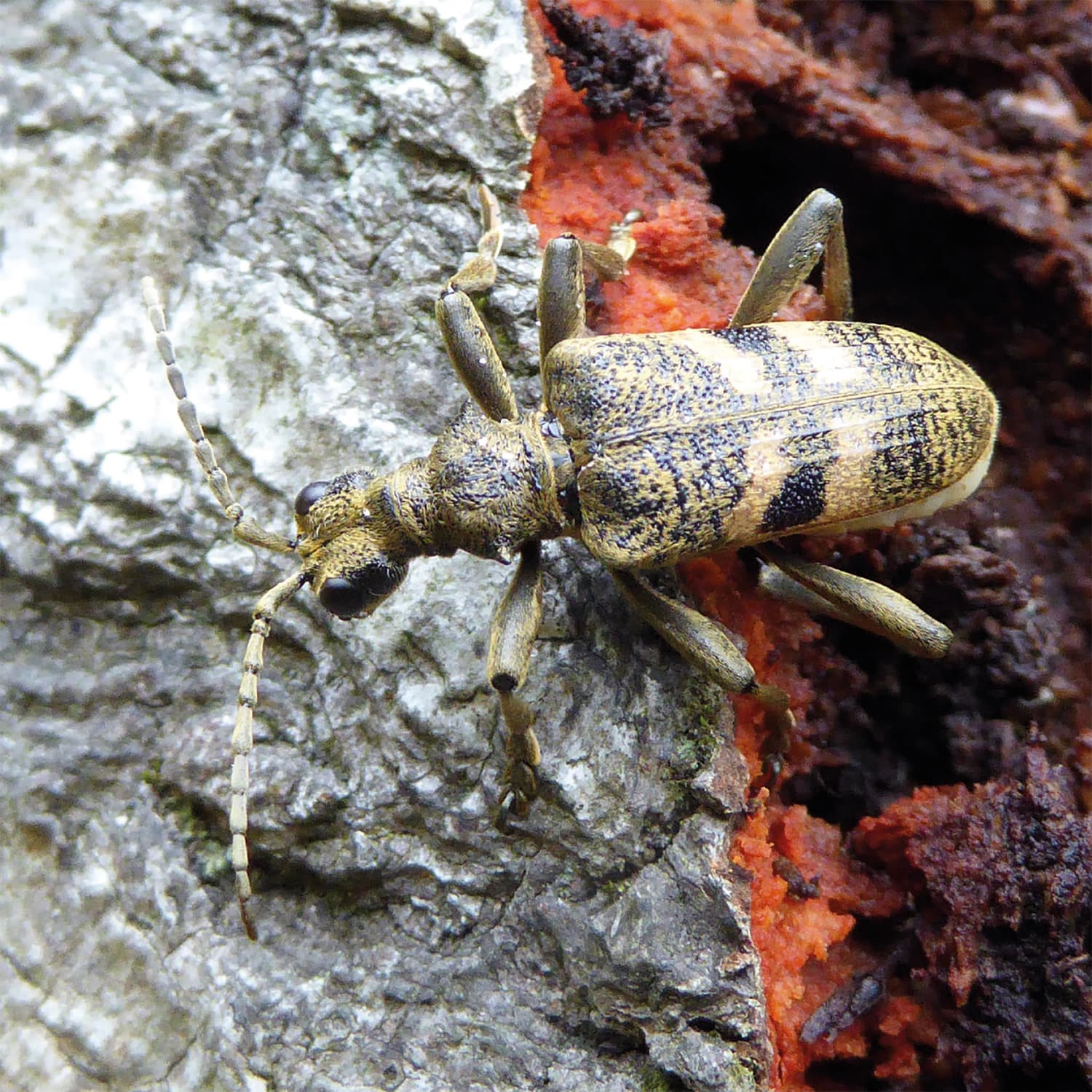
Oak longhorn Rhagium mordax photographed in the New Forest. (Keith Alexander)
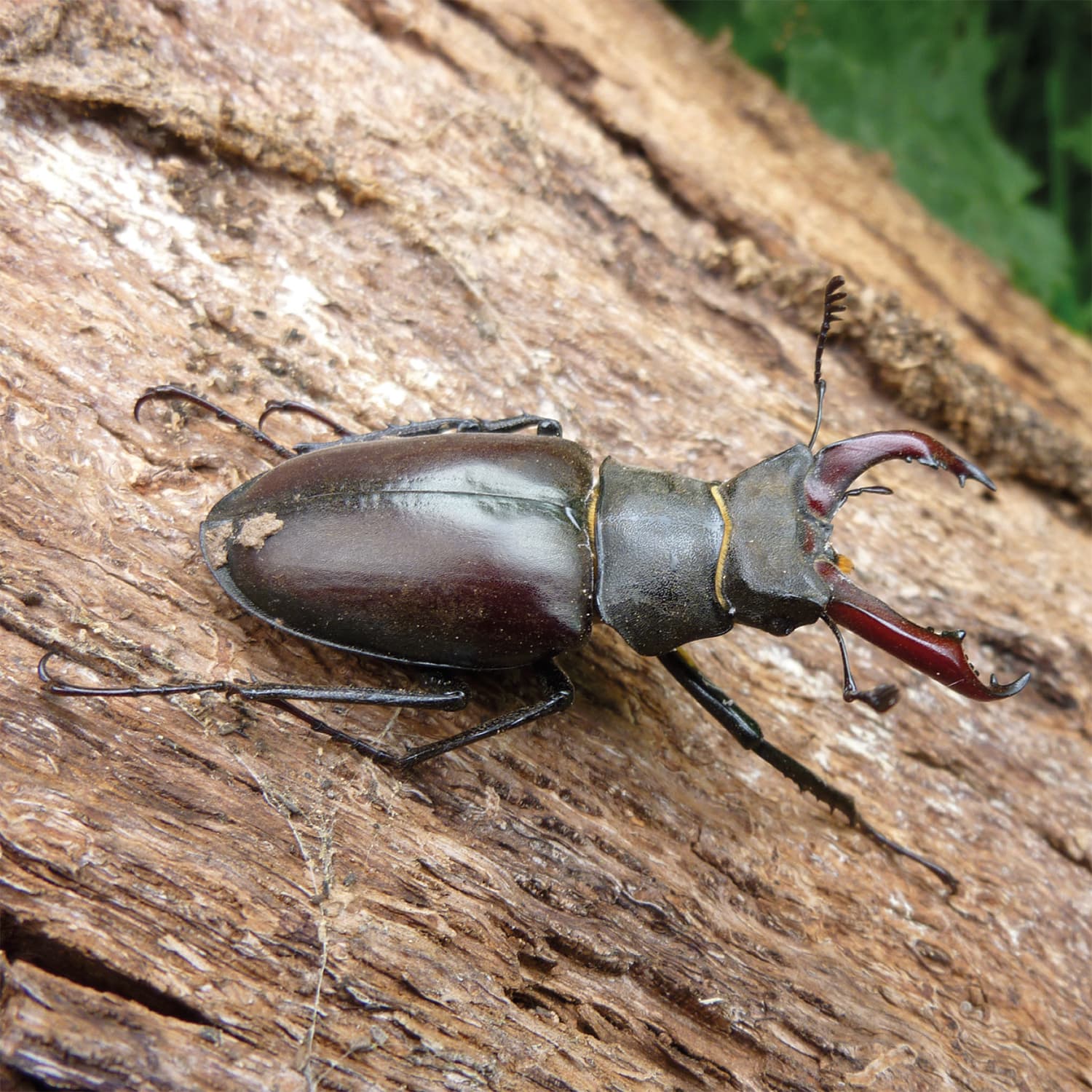
Stag beetle Lucanus cervus. (Keith Alexander)
Wood decay invertebrates
The wood decay invertebrate fauna has been reviewed (Alexander, 1999 & 2002) and so it has been relatively straight-forward to categorise the various tree and shrub species according to the range of invertebrates which exploit their decaying wood habitats. It is important to be aware that the key determining factor for the presence or absence of a particular invertebrate species is the condition of the decaying wood, which is largely due to the species of fungus rather than the species of tree. While the invertebrates attracted to freshly dead wood are more closely associated with tree species, the majority of timber invertebrates exploit decaying wood and their species composition at any one time reflects fungal activity. The fauna splits into those species which are associated with brown-rot (also referred to as red-rot), white-rot or with either.
Whether wood decays along a brown route (with the lignin remaining undecayed) or the white route (lignin and cellulose broken down) is thought to be primarily determined by the fungus species which is causing the rot. The dead heartwood of a live oak tree, for example, may be colonised by chicken-of-the-woods Laetiporus sulphureus (a brown-rot fungus) and the weeping polypore Inonotus dryadeus (a white-rot fungus) at the same time and therefore has the potential to attract specialist invertebrates which favour both types of decay. Chicken-of-the-woods may cause brown-rot in a native oak or introduced sweet chestnut, but the decay which results is equally attractive to native brown-rot invertebrates.
Species-richness of foliage invertebrates
This topic is covered in detail in the Southwood references. Kennedy & Southwood (1984) updated an earlier list of the numbers of foliage-feeding insects and mites associated with 28 British tree and shrub species (Southwood, 1961). A breakdown was provided on the numbers of species in selected insect and mite foliage-feeding groups that are specific to one species or genus of tree and/or shrub as host. The species counts ranged from 450 for Salix spp., 423 for the two native oak Quercus species and 334 for Betula spp., down to six for yew, five for evergreen oak Quercus ilex and just two for Robinia pseudoacacia. The authors went on to analyse the influence of various factors on the species totals per tree or shrub species. The key factors which affected the number of insect and mite species were abundance of the tree or shrub in Britain, the length of time that plant species had been in Britain, and whether or not it was evergreen or coniferous.
While host tree/shrub abundance was found to be the best predictor of total insect species richness, sycamore, ash, hazel, holly and horse chestnut came out poorest as having fewer species associated than might be expected from their abundance in the countryside. Of course, the number of species associated is not static in time – Parsons & Greatorex-Davies (2006) point out that over 70 moth species have been recorded feeding on sweet chestnut whereas Kennedy & Southwood (1984) cited only nine.
Some of the sap-sucking insects, e.g. aphids and scale insects, generate large quantities of honeydew as a waste product. It is an important resource of sugars, etc., exploited by many other insect species. The surplus is converted by bacteria and fungi and returned to the tree. These insects may be present in great numbers and create a large biomass of benefit to bats and other wildlife.
Biomass of foliage invertebrates
We have included the biomass option in the table because it is clearly important for foliage-feeding fauna. To say that sycamore, for example, is not good for wildlife because it does not support a species-rich foliage fauna is nonsensical when it does have a superabundance of aphids on which aphid-feeders can feast. Using biomass also enables other non-foliage-feeding invertebrates to be taken into account, e.g. predators, parasites, hyperparasites, microfungi feeders, etc. We are not aware of any publications on the invertebrate biomass of trees – and indeed have heard vertebrate ecologists bemoan this lack of knowledge!
The biomass also changes throughout the year, this varying between tree and shrub species. Thus, oak has an abundance of invertebrates within the first few weeks of coming into leaf. However, this rapidly tails off, but the decline on oak usually coincides with the build-up in the aphid biomass on sycamores, and therefore overall biomass can have continuity in mixed stands of trees but not in monocultures.
eaf litter
‘Decaying wood and leaf litter are the woodland soil of tomorrow.’
An old lady living in Monmouthshire
Of course, all leaf litter is good for wildlife in some way. The annual fall of conifer needles or seasonal fall of leaves is part of natural recycling which returns nutrients to the soil where they can be absorbed by fungi and passed on to the tree roots. But the speed of the breakdown and release of nutrients varies with the tree and shrub species which produce the litter – beech and sweet chestnut are notoriously slow to break down, while ash and sycamore are relatively fast. Sycamore leaf litter is well known to support a large worm population. The slower degradation of beech provides a deep leaf litter layer which provides extensive cover for organisms, while the fast degradation of sycamore does not. The basis for the quality scoring which we decided on is the premise that faster recycling is more beneficial to the system as less nutrient is locked away from use at any one moment in time.
There are many publications which discuss the leaf litter communities, and any selection has to be a personal choice. Spooner & Roberts (2005) are once again a good modern source on fungal decomposition, while Charles Elton’s classic The Pattern of Animal Communities (1966) still has one of the most useful discussions of leaf litter fauna.
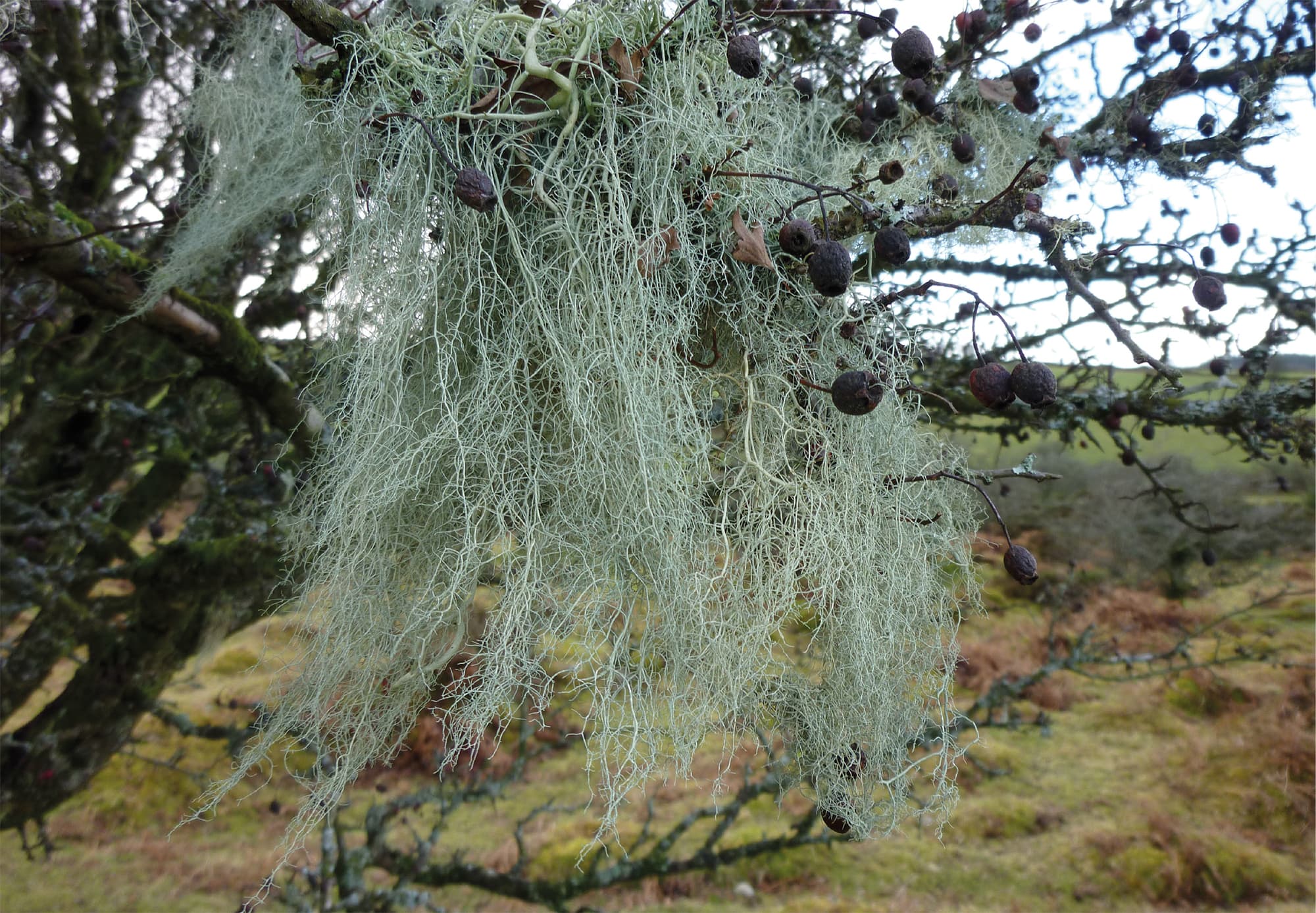
The ‘string-of-sausages’ lichen Usnea articulata on hawthorn, Dartmoor. (Keith Alexander)
Blossom
Pollen and nectar are two distinctly different resources for wildlife. Pollen is rich in protein and is believed to be an important source for egg-production in flower-visiting insects. Nectar is basically a sugar solution and provides an immediate resource of carbohydrate for flight fuel for insects. Early flowering trees and shrubs are especially important for a large number of spring-flying nectaring insects, and the annual sequence of blackthorn, sallow, hawthorn, etc. is followed by a succession of insect species. Ivy flowers from late in September to November and so is an important late nectar source. It is important not to equate flower size with wildlife value. The small flowers of holly are very attractive to a wide variety of flying insects. One of the great strengths of sycamore as a wildlife tree is its flowering in high summer when little other tree blossom is available. Most large trees are, however, wind-pollinated and do not much attract insects to their flowers, but some nevertheless are strongly attractive to insects as a result of the honeydew production by sap-sucking insects (covered under the foliage category in the table). Catkins and blossom may not be produced under conditions of shade, especially where the tree or shrub is light-demanding.
Again, there are many books which deal with pollination as a wildlife resource but Proctor et al. (1996) is a good relatively modern treatment.
Fruits and seeds
This section in the table is one of the more difficult to assess. It aims to bring together and summarise a large and disparate variety of organisms that benefit from the fruits and seeds produced by the various tree and shrub species. These include fungi and invertebrates which parasitise those fruits and seeds, as well as the mammals and birds which feed on them and contribute to their dispersal. Annual productivity is very variable. Seasonality issues are also important: pine and larch release seeds at the otherwise lean time of year of March and April and are especially important for seed-eating birds. Some birds specialise in the hard seeds – notably hawfinch and greenfinch – while soft fruits are more generally accessible.
Epiphytic lichens, mosses and ferns
Positive features of tree bark which favour epiphytic lichens are texture, relatively high porosity and absorptive capacity, and also higher pH. The great majority of epiphytic lichens are also light-demanding species. Of course, these features may change during the life of a single tree. Rose (1974) points out that young oak and the smaller branches and twigs of older trees have relatively smooth bark and can support lichens characteristic of smooth-bark trees such as beech. Older oaks, however, develop a more rugged bark and support rough-bark species. Salts in dust and splash derived from animal excreta and urine may also enrich absorptive and porous barks and enable lichen species characteristic of high nutrient barks to be present. Conifer bark tends to be acid and the dense foliage of these trees reduces light levels on their trunks, making the bark a poor place for epiphytes. But while evergreen conifers have poor epiphyte floras in southern Britain, outside of their recent native ranges, the floras tend to be richer in the native pine range of Scotland.
A numerical comparison of the lichens of different tree species was first attempted by Rose (1974). He found that in most cases there were no marked differences in the epiphyte floras on the species within most genera, the main exception being between field maple and sycamore. The richest trees for epiphytes – with the species totals provided by Rose (1974) – are the native oaks (303 species), ash (230), beech (194), the native elms (171) and sycamore (170), followed by goat and grey willows (collectively with 128), hazel (124), the birches (93), field maple (88), alder (72), holly (68), the limes (66) and hornbeam (42). However, he also pointed out that, while it is clear that the native oak species have a considerably greater number of lichen epiphytes recorded on them than any other tree species or genera occurring in Britain, no species of epiphytic lichen is actually specific to oak in Britain. Examples provided include Arthonia didyma which is very nearly confined to oak but which has been found on sweet chestnut and sycamore, and Opegrapha lyncea, another ‘oak species’ which occurs rarely on beech.
Bryophytes are more difficult to tie down to tree associations, but Rose (1974) comments that more bryophytes appear to occur on oak than on most other trees. No bryophyte epiphytes appear to be strictly host-specific. Elm and ash were picked out as other rich trees.
A few epiphytic ferns are interesting in their preferences. Common polypody Polypodium vulgare favours oak; however, James Merryweather has found several instances of epiphytic Polypodium interjectum but only on big old elders and once on a small hawthorn (and just once on sessile oak, which was a surprise). Broad buckler fern Dryopteris dilatata is frequently epiphytic.
Of course, as with the other groups, species-richness is only one feature of the wildlife value. So far as epiphyte invertebrates are concerned, quantity of epiphyte plants is perhaps more important than quality. In areas which would formerly have had species-rich lichen epiphytes but where air pollution has caused severe impoverishment, the invertebrates associated can still be surprisingly species-rich – they appear much less affected by air pollution. Another feature of invertebrate communities is the importance of structure and especially areas bare of vegetation, so a dense cover of epiphytes will favour some species, while a sparse cover with favour others.
Birds and bats
Trees and shrubs provide a wide variety of resources for birds and bats which are highly mobile exploiters of food supplies. The cavities caused by fungal decay offer suitable places for hole-nesting birds and roosting bats, while physical splits in the timber are preferred by certain bats, and the rare barbastelle is said to favour loose thick bark on the trunks of large old trees. The variety of insect life feeds the insectivorous birds and the bats, while buds, seeds and fruits provide other nutritious feeding for specialist and generalist birds alike. The value of a particular tree or shrub species to birds and bats is therefore assumed here to be a product of longevity, cavity formation and food resources.
The literature on birds is vast and only a scant review was feasible. Nonetheless, few authors actually directly address the issue of the different values of tree and shrub species. Fuller (1995) provides a useful general discussion but points out that prey selection in tree-feeding birds has not been adequately studied (R. Fuller, personal communication). Peck (1989) is one of notably few authors to have investigated the differences in bird usage between tree species, with an interesting study of the feeding behaviour of six species of arboreal passerines in a forestry plantation: blue tit, great tit, coal tit, goldcrest, chaffinch and treecreeper. The birds showed a marked preference for feeding in European larch and sycamore and tended to avoid beech and western hemlock. Each bird species, however, showed a preference for a different combination of tree species. Both bird density and the number of bird species were positively correlated with the number of tree species present. The author comments that there is virtually no recognition of tree preferences in European studies on avian foraging behaviour, the main distinction being made between broadleaved and coniferous tree species. The availability of quantities of insects and other foods is almost certainly of prime importance to the birds, not the prey species-richness. It does seem likely though that the Southwood data has no direct bearing on which tree species are more valuable to birds for feeding.
Longevity
Longevity is difficult to ascertain for any individual tree. The only way to age a tree conclusively is to count its annual rings and in hollow trees these will have long since decayed away. We have decided not to present any data on the girths of living trees. However, the girths of the largest trees in the UK and Ireland can be found on the Tree Register of the British Isles (www.tree-register.org).
The life expectancy of a tree is an important feature as regards the wildlife it supports during its lifetime. Some of the largest-girthed trees are likely to be amongst the oldest of their species. They will inevitably contain greater volumes of dead heartwood or ripewood than smaller trees and therefore have the potential to support a wider variety of wood decay fungi, invertebrates, other micro-organisms and also a greater biomass. Generally speaking, they will have the potential to provide a greater variety of roost and nest sites for bats and birds as well as a greater abundance of insect food for these animals.
Hollowing of tree trunks and limbs, which can occur in all species of tree, has been shown in some cases to prolong the lives of trees. The debris or mulch in the base of an old hollow tree is believed to be one of the original sites for the incubation of the eggs of reptiles such as grass snakes.
Conclusions
An inescapable conclusion from this study is that most species are of significant value to wildlife, irrespective of whether or not they are native in a particular area of Britain. No one species in the table has fewer than three asterisks in at least one category. However, the least valuable species – in general – do come out as walnut and Turkey oak, both introduced into Britain relatively recently.
This should not, however, be taken as a carte blanche to plant non-native tree species anywhere and everywhere. This would seriously erode the uniqueness of our plant and animal communities. The areas of our countryside least affected by human intervention – and where the tree species composition reflects undisturbed soil conditions rather than the whims of people – do have very special wildlife values and considerable interest to us humans. But in areas not constrained by these considerations, it does not make sense to emphasise one particular species in plantings just because it supports the widest range of foliage-feeding invertebrate species. More diverse plantings – in terms of spacing and pattern of planting as well as tree and shrub species – will provide more varied wildlife habitat.
We have found that the process of compiling the wildlife trees table and writing this article has expanded our own knowledge and understanding of the wildlife value of trees and shrubs. We hope that readers will find the article equally useful and stimulating. We are sure that strong feelings will be aroused by our personal – and undoubtedly idiosyncratic – analysis of the subject matter and we look forward to the debate which will inevitably follow.
Keith Alexander is a freelance ecological consultant with a special interest in tree ecology and invertebrates. Jill Butler is a freelance specialist in ancient and other veteran trees, wood pasture and parkland. Ted Green is an environmental campaigner with a special interest in trees, fungi and birds.
References and further reading
Alexander, K.N.A. (1999). The invertebrates of Britain’s wood pastures. British Wildlife 11: 108–117.
Alexander, K.N.A. (2002). The invertebrates of living and decaying timber in Britain and Ireland – a provisional annotated checklist. English Nature Research Report No. 467.
Allen, M.F. (1991). The Ecology of Mycorrhizae. Cambridge University Press.
Elton, C.S. (1966). The Pattern of Animal Communities. Chapman & Hall.
Fuller, R.J. (1995). Bird Life of Woodland and Forest. Cambridge University Press.
Green, T. (2001). Comment: Should ancient trees be designated as Sites of Special Scientific Interest? British Wildlife 12: 164–166.
Green, T. (2005). Local provenance-origins unknown. Trees 65: 24–25.
Green, T. (2005). Comment: Is there a case for the Celtic Maple or Scots Plane? British Wildlife 16 (February): 184–188.
Green, T. (2010). The importance of opengrown trees: from acorn to ancient. British Wildlife 21 (June): 334–338.
Kennedy, C.E.J, and Southwood, T.R.E. (1984). The number of species of insects associated with British trees: a re-analysis. Journal of Animal Ecology 53: 455–478.
Manning, A.D., Fischer, J. and Linenmayer, D.B. (2006). Scattered trees are keystone structures – implications for conservation. Biological Conservation 132(3): 311–321.
Merryweather, J. (2001). Comment: Meet the Glomales – the ecology of mycorrhiza. British Wildlife 13: 86–93.
Parsons, M.S., and Greatorex-Davies, N. (2006). The value of sweet chestnut Castanea sativa as a foodplant for Lepidoptera. Entomologist’s Record 118: 1–11.
Peck, K.M. (1989). Tree species preferences shown by foraging birds in forest plantations in Northern England. Biological Conservation 48: 41–57.
Preston, C.D., Pearman, D.A., and Dines, T.D. (2002). New Atlas of the British and Irish Flora. Oxford University Press.
Proctor, M., Yeo, P., and Lack, A. (1996). The Natural History of Pollination. Collins New Naturalist.
Rayner, A.D.M., and Boddy, L. (1988). Fungal Decomposition of Wood: Its Biology and Ecology. Wiley.
Rayner, A.D.M. (1993). The fundamental importance of fungi in woodlands. British Wildlife 4: 205–215.
Rose, F. (1974). The Epiphytes of Oak. In: Morris, M.G. and Perring, F.H. (eds), The British Oak: Its History and Natural History, pp. 250–273. BSBI.
Schwarze, F.W.M.R., Engels, J., and Mattheck, C. (2000). Fungal Strategies of Wood Decay in Trees. Springer.
Southwood, T.R.E. (1961). The number of species of insect associated with various trees. Journal of Animal Ecology 30: 1–8.
Spooner, B., and Roberts, P. (2005). Fungi. Collins New Naturalist.
Townsend, M. (2005). Is the social construction of native species a threat to biodiversity? ECOS 26 (3/4).
This article was taken from Issue 190 Autumn 2020 of the ARB Magazine, which is available to view free to members by simply logging in to the website and viewing your profile area.